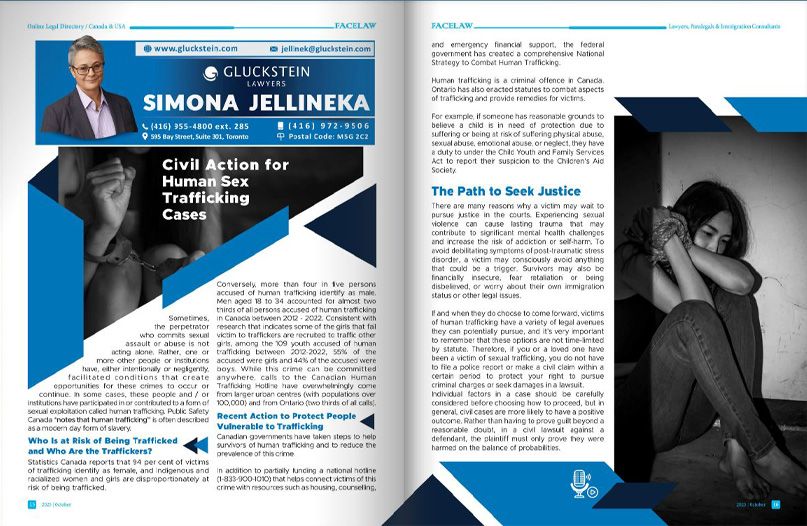Civil Action for Human Sex Trafficking Cases
Civil Action for Human Sex Trafficking Cases
Sometimes, the perpetrator who commits sexual assault or abuse is not acting alone. Rather, one or more other people or institutions have, either intentionally or negligently, facilitated conditions that create opportunities for these crimes to occur or continue. In some cases, these people and/or institutions have participated in or contributed to a form of sexual exploitation called human trafficking.
Public Safety Canada notes that human trafficking "is often described as a modern-day form of slavery.
Who Is at Risk of Being Trafficked and Who Are the Traffickers?
Statistics Canada reports that 94 per cent of victims of trafficking identify as female, and Indigenous and racialized women and girls are disproportionately at risk of being trafficked.
Conversely, more than four in five persons accused of human trafficking identify as male. Men aged 18 to 34 accounted for almost two-thirds of all persons accused of human trafficking in Canada between 2012-2022.
Consistent with research that indicates some of the girls that fall victim to traffickers are recruited to traffic other girls, among the 109 youth accused of human trafficking between 2012-2022, 55% of the accused were girls and 44% of the accused were boys.
While this crime can be committed anywhere, calls to the Canadian Human Trafficking Hotline have overwhelmingly come from larger urban centres (with populations over 100,000) and from Ontario (two-thirds of all calls).
Recent Action to Protect People Vulnerable to Trafficking.
Canadian governments have taken steps to help survivors of human trafficking and to reduce the prevalence of this crime.
In addition to partially funding a national hotline (1-833-900-1010) that helps connect victims of this crime with resources such as housing, counselling, and emergency financial support, the federal government has created a comprehensive National Strategy to Combat Human Trafficking.
Human trafficking is a criminal offence in Canada. Ontario has also enacted statutes to combat aspects of trafficking and provide remedies for victims.
For example, if someone has reasonable grounds to believe a child is in need of protection due to suffering or being at risk of suffering physical abuse, sexual abuse, emotional abuse, or neglect, they have a duty to under the Child Youth and Family Services Act to report their suspicion to the Children's Aid Society.
The Path to Seek Justice.
There are many reasons why a victim may wait to pursue justice in the courts. Experiencing sexual violence can cause lasting trauma that may contribute to significant mental health challenges and increase the risk of addiction or self-harm. To avoid debilitating symptoms of post-traumatic stress disorder, a victim may consciously avoid anything that could be a trigger. Survivors may also be financially insecure, fear retaliation or being disbelieved, or worry about their own immigration status or other legal issues.
If and when they do choose to come forward, victims of human trafficking have a variety of legal avenues they can potentially pursue, and it's very important to remember that these options are not time-limited by statute. Therefore, if you or a loved one have been a victim of sexual trafficking, you do not have to file a police report or make a civil claim within a certain period to protect your right to pursue criminal charges or seek damages in a lawsuit.
Individual factors in a case should be carefully considered before choosing how to proceed, but in general, civil cases are more likely to have a positive outcome. Rather than having to prove guilt beyond a reasonable doubt, in a civil lawsuit against a defendant, the plaintiff must only prove they were harmed on the balance of probabilities.





